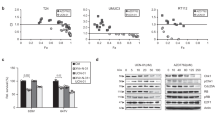Abstract
In this article, we evaluated the feasibility of the restricted replication-competent adenoviruses for treatment of anaplastic thyroid carcinomas (ATCs), which are very aggressive and difficult to treat. Because ATCs very often harbor p53 mutations, we used wt-p53 as a regulatory factor to restrict virus replication and cytopathic effect to p53-mutated cells. The recently reported “gene inactivation strategy” using p53-regulated Cre/loxP system was employed; this system consists of two recombinant adenoviruses. One has an expression unit of the synthetic p53-responsive promoter and the Cre recombinase gene (Axyp53RECre), and another contains two expression units; the first consists of E1A gene flanked by a pair of loxP sites downstream of the constitutive CAG promoter and the second E1B19K gene under the control of the CMV promoter (AdCALE1AL). We expected that coinfection of these two adenoviruses into the cells with wt-p53 would lead to expression of the Cre, which excises E1A gene and switches off E1A expression resulting in no virus replication, whereas in the cells with mutant p53 E1A could be expressed that leads to virus replication and cell lysis. Our in vitro data demonstrate that although infection of AdCALE1AL alone led to E1A expression, viral replication and cytolysis in all the thyroid cells examined irrespective of their p53 status, the double infection did so in FRO cells (p53-null ATC) but not in FRO cells stably expressing wt-p53 and normal thyroid cells with wt-p53. These data indicate that our double infection method may have a potential for treatment of ATC and probably also other p53-defective cancer cells. Cancer Gene Therapy (2001) 8, 36–44
This is a preview of subscription content, access via your institution
Access options
Subscribe to this journal
Receive 12 print issues and online access
$259.00 per year
only $21.58 per issue
Buy this article
- Purchase on Springer Link
- Instant access to full article PDF
Prices may be subject to local taxes which are calculated during checkout
Similar content being viewed by others
Author information
Authors and Affiliations
Corresponding author
Rights and permissions
About this article
Cite this article
Nagayama, Y., Nishihara, E., Namba, H. et al. Targeting the replication of adenovirus to p53-defective thyroid carcinoma with a p53-regulated Cre/loxP system. Cancer Gene Ther 8, 36–44 (2001). https://doi.org/10.1038/sj.cgt.7700276
Received:
Accepted:
Issue Date:
DOI: https://doi.org/10.1038/sj.cgt.7700276
Keywords
This article is cited by
-
Expression of HIF-1α ODD domain fused canine caspase 3 by EGFR promoter-driven adenovirus vector induces cytotoxicity in canine breast tumor cells under hypoxia
Veterinary Research Communications (2016)
-
Genetic mutations in the treatment of anaplastic thyroid cancer: a systematic review
BMC Surgery (2013)
-
Enhanced antitumor effect of combined replicative adenovirus and nonreplicative adenovirus expressing interleukin-12 in an immunocompetent mouse model
Gene Therapy (2003)



